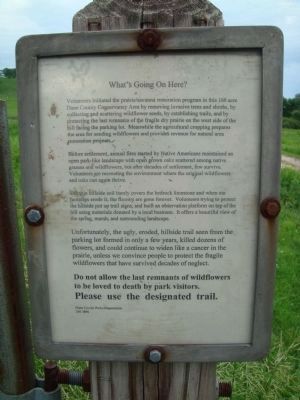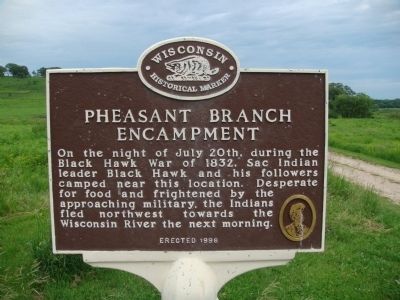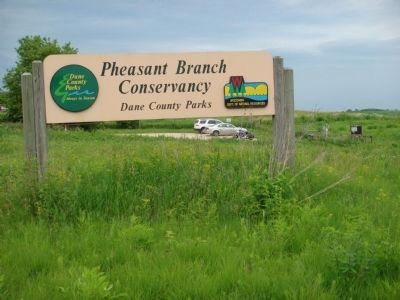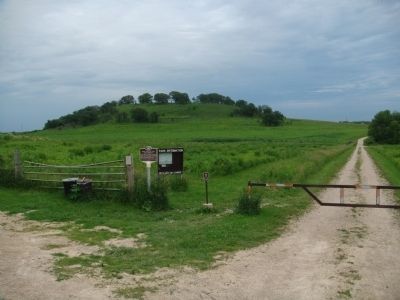Near Middleton in Dane County, Wisconsin — The American Midwest (Great Lakes)
Pheasant Branch Encampment
Erected 1998. (Marker Number 398.)
Topics and series. This historical marker is listed in these topic lists: Military • Native Americans • Wars, US Indian. In addition, it is included in the Black Hawk War, and the Wisconsin Historical Society series lists. A significant historical date for this entry is July 20, 1880.
Location. 43° 7.34′ N, 89° 29.465′ W. Marker is near Middleton, Wisconsin, in Dane County. Marker is on Pheasant Branch Road, 0.4 miles north of Whittlesey Road, on the right when traveling north. Touch for map. Marker is in this post office area: Middleton WI 53562, United States of America. Touch for directions.
Other nearby markers. At least 8 other markers are within 4 miles of this marker, measured as the crow flies. The Stamm House (approx. 1.2 miles away); Mendota (approx. 1.4 miles away); Early Social Whirl (approx. 1.8 miles away); Thorstrand (approx. 2.2 miles away); The Lemcke Farm House (approx. 2.4 miles away); Hickory Hill House (approx. 2.6 miles away); Hocheera (approx. 2.8 miles away); Blackhawk Country Club Mound Group (approx. 3.3 miles away). Touch for a list and map of all markers in Middleton.

Photographed By William J. Toman, June 10, 2010
4. Pheasant Branch Park Description
This sign next to the marker, "What's Going On Here?," describes efforts to restore the park:
Volunteers initiated the prairie/savanna restoration program in this 160 acre Dane County Conservancy Area by removing invasive trees and shrubs, by collecting and scattering wildflower seeds, by establishing trails, and by protecting the last remnants of the fragile dry prairie on the west side of the hill facing the parking lot. Meanwhile the agricultural cropping prepares the area for seeding wildflowers and provides revenue for natural area restoration project.
Before settlement, annual fires started by Native Americans maintained an open park-like landscape with open grown oaks scattered among native grasses and wildflowers, but after decades of settlement, few survive. Volunteers are recreating the environment where the original wildflowers and oaks can again thrive.
The thin hillside soil barely covers the bedrock limestone and when our footsteps erode it, the flowers are gone forever. Volunteers are trying to protect the hillside put up trail signs, and built an observation platform on top of the hill using materials donated by a local business. It offers a beautiful view of the spring, marsh, and surrounding landscape.
Unfortunately, the ugly, eroded hillside trail seen from the parking lot formed in only a few years, killed dozens of flowers, and could continue to widen like a cancer in the prairie, unless we convince people to protect the fragile wildflowers that have survived decades of neglect.
Do not allow the last remnants of wildflowers to be loved to death by park visitors. Please use the designated trail.
Volunteers initiated the prairie/savanna restoration program in this 160 acre Dane County Conservancy Area by removing invasive trees and shrubs, by collecting and scattering wildflower seeds, by establishing trails, and by protecting the last remnants of the fragile dry prairie on the west side of the hill facing the parking lot. Meanwhile the agricultural cropping prepares the area for seeding wildflowers and provides revenue for natural area restoration project.
Before settlement, annual fires started by Native Americans maintained an open park-like landscape with open grown oaks scattered among native grasses and wildflowers, but after decades of settlement, few survive. Volunteers are recreating the environment where the original wildflowers and oaks can again thrive.
The thin hillside soil barely covers the bedrock limestone and when our footsteps erode it, the flowers are gone forever. Volunteers are trying to protect the hillside put up trail signs, and built an observation platform on top of the hill using materials donated by a local business. It offers a beautiful view of the spring, marsh, and surrounding landscape.
Unfortunately, the ugly, eroded hillside trail seen from the parking lot formed in only a few years, killed dozens of flowers, and could continue to widen like a cancer in the prairie, unless we convince people to protect the fragile wildflowers that have survived decades of neglect.
Do not allow the last remnants of wildflowers to be loved to death by park visitors. Please use the designated trail.
Credits. This page was last revised on June 16, 2016. It was originally submitted on June 10, 2010, by William J. Toman of Green Lake, Wisconsin. This page has been viewed 1,859 times since then and 110 times this year. Photos: 1, 2, 3, 4. submitted on June 10, 2010, by William J. Toman of Green Lake, Wisconsin. • J. J. Prats was the editor who published this page.


